#Red-Billed Streamertail
Explore tagged Tumblr posts
Text

Happy Independence Day to Jamaicans everywhere 🇯🇲
Jamaica gained its independence from Britain 62 years ago on August 6, 1962.
Did you know that the Red-Billed Streamertail is endemic to Jamaica? This hummingbird species is also the national bird of Jamaica, where it’s called the “Doctor Bird” because the male’s long, black tail feathers and black crest have a striking resemblance to the coattails and top hat of doctors in the past.
#Jamaica#Independence Day#Red-Billed Streamertail#Caribbean#Latin America#Caribbean culture#hummingbird#Know the Caribbean
16 notes
·
View notes
Text
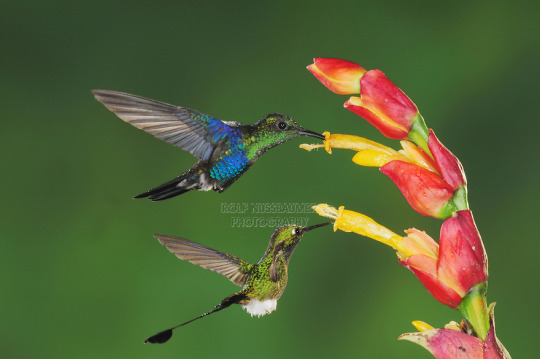
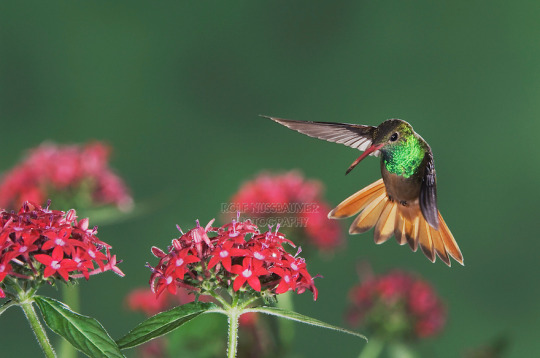
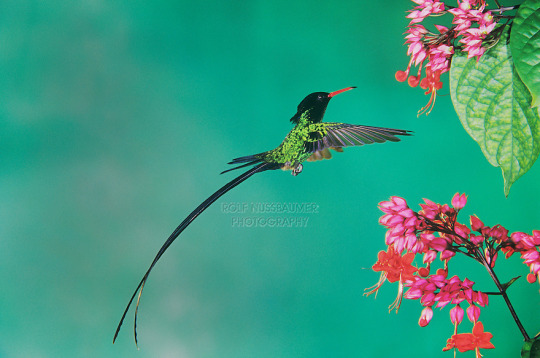
Hummingbirds by Rolf Nussbaumer
Top: Booted Racket-tail (Ocreatus spp.) and Green-Crowned Woodnymph (Thalurania colombica)
Middle: Buff-bellied Hummingbird (Amazilia yucatanenensis)
Bottom: Red-billed Streamertail (Trochilus polytmus)
#Ocreatus#Booted Racket-tail#Green-Crowned Woodnymph#Thalurania colombica#Amazilia yucatanenensis#Buff-bellied Hummingbird#Trochilus polytmus#Red-billed streamertail#hummingbirds#birds#bird photography#flowers#nature#animals
13 notes
·
View notes
Text


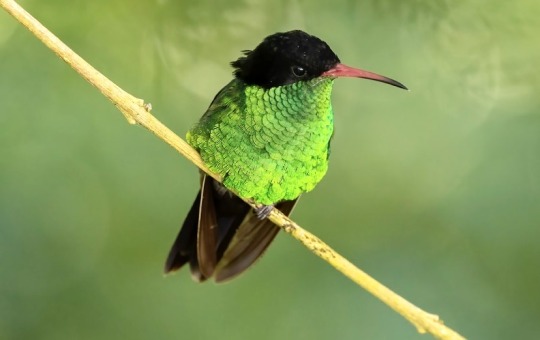

the red-billed streamertail is a species of hummingbird named for the males’ two distinct ‘streamer’ tail feathers. they are exclusively found in jamaica, where they are the national bird. as their name implies, they also have a bright red bill. females are duller in color than the stark black and emerald green males, and they lack the distinct tail plumage. like other hummingbirds, they feed primarily on various nectars, but also on small insects. they are prolific breeders and can raise up to three clutches within a breeding season; both parents work together to raise the young.
2K notes
·
View notes
Text

Some sorta old doodles of an OC. His name is Bennett and his family owns a grocery. Might post some other characters too going forward, when I have more time
1 note
·
View note
Text

Red-billed Streamertail aka Scissortail Hummingbird (Trochilus polytmus), male, family Trochilidae, Montego Bay, Jamaica
photograph by Joaquin Garcia
341 notes
·
View notes
Text

[https://www.inaturalist.org/observations/203750014]
Red-Billed Streamertail || Trochilus polytmus
Observed in Jamaica
Least Concern in location of observation
#hummingbird#birds#nature#wildlife#photography#air beast#who cooks for queue? who cooks for queue all?
14 notes
·
View notes
Text

Joaquin Garcia
The red-billed streamertail (Trochilus polytmus) also known as the doctor bird, scissor-tail or scissors tail hummingbird.
Montego Bay, Jamaica.
56 notes
·
View notes
Note
So birb xenofiction? 👀
Just copying and pasting my notes
Watched the Bob Marley movie and it just switched a thing in my brain about my Jamaican heritage and made me go into over drive as well as rewatching Rio.
Somewhat going back and forth on regular animals versions or anthro cuz I kinda want them to have weapons like swords and armor but it works either way.
Mostly trying to go for birds only found in jamaica but I'm not too picky.
It’s fun to work on how the different types of birds from the islands are as a culture and towards each other, obvs planning a conlang.
The plot itself is up in the air, got a short stories/slice of game of thrones life currently.
I specifically have a cuckoo character in mind who I'm losing my mind over. Like a character based solely on motherhood isn't great but this is a cuckoo, it goes against her very nature which is what makes it interesting.
Though keep in mind, I have never read/watched guardians of ga’hoole so if I say anything similar to it, it’s not on purpose.
Song is everything to most species. Combat engages with song, its not a sport (for most), its an art and to disrespect is like turning your back on the rising sun.
A good majority worship the rising sun and their language and culture definitely reflects that in some cases.
Here's a few:
Hummingirds (Jamaican Mango, red/black-billed streamertail): what they lack in size, they make up for in attitude. They live in empires compared to the usual kingdoms or coalitions that the other species have. The jamican mango in particular often find themselves overseeing other species districts alongside Cuckoos.
Parrots (Yellow/Black-tipped parrot): the most common, everywhere and everywhere. Chatty and petty as hell. Paired on with humming birds when it comes to involving themselves in politics. They're networking is only outdone with the Crows.
Pigeons (crested quail-dove and Ring-tailed pigeon): the workhorse of the species so to speak. They're everywhere, doing all sorts of odd jobs and mercenary work. General middle class.
Cuckoos (Chestnut-bellied and Jamaican-lizard): tricksters of flight with their unorthidox and downright horrid parenting (read: lack-thereof). Groups of nomadic females spotted make a game with surrounding bird groups of combat which they win majority of the time and get to dump their eggs. Many know its better to just deal with the additional egg and most of the time get to keep their original clutch if they play nice. Don't hate the player, hate the game. Involved in polities more than most think they are.
Corvid (Jamaican Crow): referred to as the warlocks of the islands for their practices with the spirits and their emphasis on traditions and ceremonies. If there's ever a species to not cross, it's them. At the fore front in politics and typically either have simple murders or kingdoms.
Plenty of bird drama ideas truely
6 notes
·
View notes
Text
All animal species (and a couple algae) that have kept the same scientific name since Linnaeus
The first work of taxonomy that is considered as having any scientific authority for animal species was the 10th edition of Linnaeus' Systema Naturae, published in 1758. (Also a book on spiders called Aranei Suecici, published one year before.) That's the foundational text of the binominal system of nomenclature of species still in use today. Since then most of Linnaeus' original species (4379 species, of which 185 mammals, 554 birds, 217 "amphibians" (including reptiles and cartilaginous fish), 379 fishes, 2104 "insects" (including various arthropods, of which 664 are beetles and 543 are moths & butterflies crammed into only 3 genera), and 940 "worms" (including basically all other invertebrates, and even some protists and algae)) have been dismembered, renamed, or at least moved to different genera (e.g. the house sparrow went from Fringilla domestica to Passer domesticus).
Here is a list of all of Linnaeus' original species from 1758 that still retain their original name. I believe they are 484 in total.
"Mammalia"
(Primates)
Homo sapiens (human)
Lemur catta (ring-tailed lemur)
Vespertilio murinus (rearmouse bat)
(Bruta)
Elephas maximus (Asian elephant)
Trichechus manatus (West Indian manatee)
Bradypus tridactylus (three-toed sloth)
Myrmecophaga tridactyla (giant anteater)
Manis pentadactylus (Chinese pangolin)
(Ferae)
Phoca vitulina (harbor seal)
Canis familiaris (dog)
Canis lupus (grey wolf)
Felis catus (house cat)
Viverra zibetha (Indian civet)
Mustela erminea (stoat)
Mustela furo (ferret)
Mustela lutreola (European mink)
Mustela putorius (wild ferret)
Ursus arctos (brown bear)
(Bestiae)
Sus scrofa (wild boar/pig)
Dasypus septemcinctus (seven-banded armadillo)
Dasypus novemcinctus (nine-banded armadillo)
Erinaceus europaeus (European hedgehog)
Talpa europaea (European mole)
Sorex araneus (common shrew)
Didelphis marsupialis (common opossum)
(Glires)
Rhinoceros unicornis (Indian rhinoceros)
Hystrix brachyura (Malayan porcupine)
Hystrix cristata (crested porcupine)
Lepus timidus (common hare)
Castor fiber (European beaver)
Mus musculus (house mouse)
Sciurus vulgaris (red squirrel)
(Pecora)
Camelus dromedarius (dromedary camel)
Camelus bactrianus (Asian camel)
Moschus moschiferus (musk deer)
Cervus elaphus (red deer)
Capra hircus (goat)
Capra ibex (Alpine ibex)
Ovis aries (sheep)
Bos taurus (cow)
Bos indicus (zebu)
(Belluae)
Equus caballus (horse)
Equus asinus (donkey)
Equus zebra (mountain zebra)
Hippopotamus amphibius (hippopotamus)
(Cete)
Monodon monoceros (narwhal)
Balaena mysticetus (bowhead whale)
Physeter macrocephalus (sperm whale)
Delphinus delphis (common dolphin)
"Aves"
(Accipitres)
Vultur gryphus (Andean condor)
Falco tinnunculus (common kenstrel)
Falco sparverius (sparrowhawk)
Falco columbarius (pigeonhawk)
Falco subbuteo (Eurasian hobby)
Falco rusticolus (gyrfalcon)
Strix aluco (tawny owl)
Lanius excubitor (great grey shrike)
Lanius collurio (red-backed shrike)
Lanius schach (long-tailed shrike)
(Picae)
Psittacus erithacus (grey parrot)
Ramphastos tucanus (white-throated toucan)
Buceros bicornis (great hornbill)
Buceros rhinoceros (rhinoceros hornbill)
Crotophaga ani (smooth-billed ani)
Corvus corax (raven)
Corvus corone (carrion crow)
Corvus frugilegus (rook)
Corvus cornix (hooded crow)
Coracias oriolus (golden oriole)
Coracias garrulus (European roller)
Gracula religiosa (hill myna)
Paradisaea apoda (greater bird-of-paradise)
Cuculus canorus (common cuckoo)
Jynx torquilla (wryneck)
Picus viridis (green woodpecker)
Sitta europaea (Eurasian nuthatch)
Merops apiaster (European bee-eater)
Merops viridis (blue-throated bee-eater)
Upupa epops (Eurasian hoopoe)
Certhia familiaris (Eurasian treecreeper)
Trochilus polytmus (red-billed streamertail hummingbird)
(Anseres)
Anas platyrhynchos (mallard duck)
Anas crecca (teal duck)
Mergus merganser (common merganser)
Mergus serrator (red-breasted merganser)
Alca torda (razorbill auk)
Procellaria aequinoctialis (white-chinned petrel)
Diomedea exulans (wandering albatross)
Pelecanus onocrotalus (great white pelican)
Phaeton aethereus (red-billed tropicbird)
Larus canus (common gull)
Larus marinus (great black-backed gull)
Larus fuscus (lesser black-backed gull)
Sterna hirundo (common tern)
Rhynchops niger (black skimmer)
(Grallae)
Phoenicopterus ruber (American flamingo)
Platalea leucorodia (Eurasian spoonbill)
Platalea ajaia (roseate spoonbill)
Mycteria americana (wood stork)
Ardea cinerea (grey heron)
Ardea herodias (blue heron)
Ardea alba (great egret)
Scolopax rusticola (Eurasian woodcock)
Charadrius hiaticula (ringed plover)
Charadrius alexandrinus (Kentish plover)
Charadrius vociferus (killdeer plover)
Charadrius morinellus (Eurasian dotterel)
Recurvirostra avosetta (pied avocet)
Haematopus ostralegus (Eurasian oystercatcher)
Fulica atra (Eurasian coot)
Rallus aquaticus (water rail)
Psophia crepitans (grey-winged trumpeter)
Otis tarda (great bustard)
Struthio camelus (ostrich)
(Gallinae)
Pavo cristatus (Indian peafowl)
Meleagris gallopavo (wild turkey)
Crax rubra (great curassow)
Phasianus colchicus (common pheasant)
Tetrao urogallus (western capercaillie)
(Passeres)
Columba oenas (stock dove)
Columba palumbus (wood pigeon)
Alauda arvensis (Eurasian skylark)
Sturnus vulgaris (European starling)
Turdus viscivorus (mistle thrush)
Turdus pilaris (fieldfare thrush)
Turdus iliacus (redwing thrush)
Turdus plumbeus (red-legged thrush)
Turdus torquatus (ring ouzel)
Turdus merula (blackbird)
Loxia curvirostra (crossbill)
Emberiza hortulana (ortolan bunting)
Emberiza citrinella (yellowhammer)
Emberiza calandra (corn bunting)
Fringilla coelebs (common chaffinch)
Motacilla alba (white wagtail)
Motacilla lava (yellow wagtail)
Parus major (great tit)
Hirundo rustica (barn swallow)
Caprimulgus europaeus (European nightjar)
"Amphibia"
(Reptiles)
Testudo graeca (Greek tortoise)
Draco volans (flying dragon)
Lacerta agilis (sand lizard)
Rana temporaria (common frog)
(Serpentes)
Crotalus horridus (timber rattlesnake)
Crotalus durissus (tropical rattlesnake)
Boa constrictor (common boa)
Coluber constrictor (eastern racer)
Anguis fragilis (slowworm)
Amphisbaena alba (red worm lizard)
Caecilia tentaculata (white-bellied caecilian)
(Nantes)
Petromyzon marinus (sea lamprey)
Raja clavata (thornback ray)
Raja miraletus (brown ray)
Squalus acanthias (spiny dogfish)
Chimaera monstrosa (rabbitfish)
Lophius piscatorius (anglerfish)
Acipenser sturio (sea sturgeon)
Acipenser ruthenus (sterlet sturgeon)
"Pisces"
(Apodes)
Muraena helena (Mediterranean moray)
Gymnotus carapo (banded knifefish)
Trichiurus lepturus (cutlassfish)
Anarhichas lupus (Atlantic wolffish)
Ammodytes tobianus (lesser sandeel)
Xiphias gladius (swordfish)
Stromateus fiatola (blue butterfish)
(Jugulares)
Callionymus lyra (common dragonet)
Uranoscopus scaber (stargazer)
Trachinus draco (greater weever)
Gadus morhua (Atlantic cod)
Blennius ocellaris (butterfly blenny)
Ophidion barbatum (snake cusk-eel)
(Thoracici)
Cyclopterus lumpus (lumpsucker)
Echeneis naucrates (sharksucker)
Coryphaena equiselis (pompano)
Coryphaena hippurus (dorado)
Gobius niger (black goby)
Govius paganellus (rock goby)
Cottus gobio (European bullhead)
Scorpaena porcus (black scorpionfish)
Scorpaena scrofa (red scorpionfish)
Zeus faber (John Dory)
Pleuronectes platessa (European plaice)
Chaetodon striatus (banded butterflyfish)
Chaetodon capistratus (foureye butterflyfish)
Sparus aurata (gilt-head bream)
Labrus merula (brown wrasse)
Labrus mixtus (cuckoo wrasse)
Labrus viridis (green wrasse)
Sciaena umbra (brown meagre)
Perca fluviatilis (European perch)
Gasterosteus aculeatus (three-spined stickleback)
Scomber scombrus (Atlanti mackerel)
Mullus barbatus (red mullet)
Mullus surmuletus (surmullet)
Trigla lyra (piper gurnard)
(Abdominales)
Cobitis taenia (spined loach)
Silurus asotus (Amur catfish)
Silurus glanis (Wels catfish)
Loricaria cataphracta (suckermouth catfish)
Salmo carpio (Garda trout)
Salmo trutta (brown trout)
Salmo salar (Atlantic salmon)
Fistularia tabacaria (bluespotted cornetfish)
Esox lucius (northern pike)
Argentina sphyraena (European argentine)
Atherina hepsetus (Mediterranean sand smelt)
Mugil cephalus (flathead mullet)
Exocoetus volitans (tropical flying fish)
Polynemus paradiseus (Paradise threadfin)
Clupea harengus (Atlantic herring)
Cyprinus carpio (common carp)
(Branchiostegi)
Mormyrus caschive (bottlenose elephantfish)
Balistes vetula (queen triggerfish)
Ostracion cornutus (longhorn cowfish)
Ostracion cubicus (yellow boxfish)
Tetraodon lineatus (Fahaka pufferfish)
Diodon hystrix (spot-fin porcupinefish)
Diodon holocanthus (long-spine porcupinefish)
Centriscus scutatus (grooved shrimpfish)
Syngnathus acus (common pipefish)
Syngnathus pelagicus (pelagic pipefish)
Syngnathus typhle (broad-nosed pipefish)
Pegasus volitans (longtail seamoth)
"Insecta"
(Coleoptera)
Scarabaeus sacer (sacred scarab)
Dermestes lardarius (larder beetle)
Dermestes murinus (larder beetle)
Hister unicolor (clown beetle)
Hister quadrimaculatus (clown beetle)
Silpha obscura (carrion beetle)
Cassida viridis (tortoise beetle)
Cassida nebulosa (tortoise beetle)
Cassida nobilis (tortoise beetle)
Coccinella trifasciata (ladybug)
Coccinella hieroglyphica (ladybug) [Coccinella 5-punctata, 7-punctata, 11-punctata, and 24-punctata survive as quinquepunctata, septempunctata, undecimpunctata, and vigintiquatorpunctata]
Chrysomela populi (leaf beetle)
Chrysomela lapponica (leaf beetle)
Chrysomela collaris (leaf beetle)
Chrysomela erythrocephala (leaf beetle)
Curculio nucum (nut weevil)
Attelabus surinamensis (leaf-rolling weevil)
Cerambyx cerdo (capricorn beetle)
Leptura quadrifasciata (longhorn beetle)
Cantharis fusca (soldier beetle)
Cantharis livida (soldier beetle)
Cantharis oscura (soldier beetle)
Cantharis rufa (soldier beetle)
Cantharis lateralis (soldier beetle)
Elater ferrugineus (rusty click beetle)
Cicindela campestris (green tiger beetle)
Cicindela sylvatica (wood tiger beetle)
Buprestis rustica (jewel beetle) [Buprestis 8-guttata survives as octoguttata]
Dytiscus latissimus (diving beetle)
Carabus coriaceus (ground beetle)
Carabus granulatus (ground beetle)
Carabus nitens (ground beetle)
Carabus hortensis (ground beetle)
Carabus violaceus (ground beetle)
Tenebrio molitor (mealworm)
Meloe algiricus (blister beetle)
Meloe proscarabaeus (blister beetle)
Meloe spec (blister beetle)
Mordela aculeata (tumbling glower beetle)
Necydalis major (longhorn beetle)
Staphylinus erythropterus (rove beetle)
Forficula auricularia (common earwig)
Blatta orientalis (Oriental cockroach)
Gryllus campestris (field cricket)
(Hemiptera)
Cicada orni (cicada)
Notonecta glauca (backswimmer)
Nepa cinerea (water scorpion)
Cimex lectularius (bedbug)
Aphis rumici (black aphid)
Aphis craccae (vetch aphid)
Coccus hesperidum (brown scale insect)
Thrips physapus (thrips)
Thrips minutissimum (thrips)
Thrips juniperinus (thrips)
(Lepidoptera)
Papilio paris (Paris peacock butterfly)
Papilio helenus (red Helen butterfly)
Papilio troilus (spicebush swallowtail butterfly)
Papilio deiphobus (Deiphobus swallowtail butterfly)
Papilio polytes (common Mormon butterfly)
Papilio glaucus (eastern tiger swallowtail butterfly)
Papilio memnon (great Mormon butterfly)
Papilio ulysses (Ulysses butterfly)
Papilio machaon (Old World swallowtail butterfly)
Papilio demoleus (lime swallowtail butterfly)
Papilio nireus (blue-banded swallowtail butterfly)
Papilio clytia (common mime butterfly)
Sphinx ligustri (privet hawk-moth)
Sphinx pinastri (pine hawk-moth) [genus Phalaena was suppressed, but seven subgenera created by Linnaeus are now valid as genera]
(Neuroptera)
Libellula depressa (chaser dragonfly)
Libellula quadrimaculata (four-spotted skimmer dragonfly)
Ephemera vulgata (mayfly)
Phryganea grandis (caddisfly)
Hemerobius humulinus (lacewing)
Panorpa communis (scorpionfly)
Panorpa germanica (scorpionfly)
Raphidia ophiopsis (snakefly)
(Hymenoptera)
Cynips quercusfolii (oak gall wasp)
Tenthredo atra (sawfly)
Tenthredo campestris (sawfly)
Tenthredo livida (sawfly)
Tenthredo mesomela (sawfly)
Tenthredo scrophulariae (sawfly)
Ichneumon extensorius (parasitoid wasp)
Ichneumon sarcitorius (parasitoid wasp)
Sphex ichneumoneus (digger wasp)
Vespa crabro (European hornet)
Apis mellifera (honey bee)
Formica fusca (silky ant)
Mutilla europaea (large velvet ant)
(Diptera)
Oestrus ovis (sheep botfly)
Tipula oleracea (marsh cranefly)
Tipula hortorum (cranefly)
Tipula lunata (cranefly)
Musca domestica (housefly)
Tabanus bovinus (pale horsefly)
Tabanus calens (horsefly)
Tabanus bromius (brown horsefly)
Tabanus occidentalis (horsefly)
Tabanus antarcticus (horsefly)
Culex pipiens (house mosquito)
Empis borealis (dance fly)
Empis pennipes (dance fly)
Empis livida (dance fly)
Conops flavipes (thick-headed fly)
Asilus barbarus (robberfly)
Asilus crabroniformis (hornet robberfly)
Bombylius major (bee fly)
Bombylius medius (bee fly)
Bombylius minor (bee fly)
Hippobosca equina (forest fly)
(Aptera)
Lepisma saccharina (silverfish)
Podura aquatica (water springtail)
Termes fatale (termite)
Pediculus humanus (human louse)
Pulex irritans (human flea)
Acarus siro (flour mite)
Phalangium opilio (harvestman)
Araneus angulatus (orb-weaving spider)
Araneus diadematus (European garden spider)
Araneus marmoreus (marbled orbweaver)
Araneus quadratus (four-spotted orbweaver -- last four are by Clerck 1757, some of the very few surviving pre-Linnean names!)
Scorpio maurus (large-clawed scorpion)
Cancer pagurus (brown crab)
Oniscus asellus (common woodlouse)
Scolopendra gigantea (giant centipede)
Scolopendra morsitans (red-headed centipede)
Julus fuscus (millipede)
Julus terrestris (millipede)
"Vermes"
(Intestina)
Gordius aquaticus (horsehair worm)
Lumbricus terrestris (common earthworm)
Ascaris lumbricoides (giant roundworm)
Fasciola hepatica (liver fluke)
Hirudo medicinalis (medicinal leech)
Myxine glutinosa (Atlantic hagfish)
Teredo navalis (shipworm)
[shout out to Furia infernalis, a terrifying carnivorous jumping worm that Linnaeus described, but which doesn't seem to actually exist]
(Mollusca)
Limax maximus (leopard slug)
Doris verrucosa (warty nudibranch)
Nereis caerulea (ragworm)
Nereis pelagica (ragworm)
Aphrodita aculeata (sea mouse)
Lernaea cyprinacea (anchor worm)
Scyllaea pelagica (Sargassum nudibranch)
Sepia officinalis (common cuttlefish)
Asterias rubens (common starfish)
Echinus esculentus (edible sea urchin)
(Testacea)
Chiton tuberculatus (West Indian green chiton)
Lepas anatifera (goose barnacle)
Pholas dactylus (common piddock)
Mya arenaria (softshell clam)
Mya truncata (truncate softshell)
Solen vagina (razor clam)
Tellina laevigata (smooth tellin)
Tellina linguafelis (cat-tongue tellin)
Tellina radiata (sunrise tellin)
Tellina scobinata (tellin)
Cardium costatum (ribbed cockle)
Donax cuneatus (wedge clam)
Donas denticulatus (wedge clam)
Donax trunculus (wedge clam)
Venus casina (Venus clam)
Venus verrucosa (warty venus)
Spondylus gaederopus (thorny oyster)
Spondylus regius (thorny oyster)
Chama lazarus (jewel box shell)
Chama gryphoides (jewel box shell)
Arca noae (Noah's ark shell)
Ostrea edulis (edible oyster)
Anomia aurita (saddle oyster)
Anomia ephippium (saddle oyster)
Anomia hysterita (saddle oyster)
Anomia lacunosa (saddle oyster)
Anomia spec (saddle oyster)
Anomia striatula (saddle oyster)
Mytilus edulis (blue mussel)
Pinna muricata (pen shell)
Pinna nobilis (fan mussel)
Pinna rudis (rough pen shell)
Argonauta argo (argonaut)
Nautilus pompilius (chambered nautilus)
Conus ammiralis (admiral cone snail)
Conus aulicus (princely cone snail)
Conus aurisiacus (cone snail)
Conus betulinus (betuline cone snail)
Conus bullatus (bubble cone snail)
Conus capitaneus (captain cone snail)
Conus cedonulli (cone snail)
Conus ebraeus (black-and-white cone snail)
Conus figulinus (fig cone snail)
Conus genuanus (garter cone snail)
Conus geographus (geographer cone snail)
Conus glaucus (glaucous cone snail)
Conus granulatus (cone snail)
Conus imperialis (imperial cone snail)
Conus litteratus (lettered cone snail)
Conus magus (magical cone snail)
Conus marmoreus (marbled cone snail)
Conus mercator (trader cone snail)
Conus miles (soldier cone snail)
Conus monachus (monastic cone snail)
Conus nobilis (noble cone snail)
Conus nussatella (cone snail)
Conus princeps (prince cone snail)
Conus spectrum (spectrecone snail)
Conus stercusmuscarum (fly-specked cone snail)
Conus striatus (striated cone snail)
Conus textile (cloth-of-gold cone snail)
Conus tulipa (tulip cone snail)
Conus varius (freckled cone snail)
Conus virgo (cone snail)
Cypraea tigris (tiger cowry shell)
Bulla ampulla (Pacific bubble shell)
Voluta ebraea (Hebrew volute)
Voluta musica (music volute)
Buccinum undatum (common whelk)
Strombus pugilis (fighting conch)
Murex tribulus (caltrop murex)
Trochus maculatus (maculated top shell)
Turbo acutangulus (turban shell)
Turbo argyrostomus (silver-mouth turban shell)
Turbo chrystostomus (gold-mouth turban shell)
Turbo marmoratus (green turban shell)
Turbo petholatus (turban shell)
Turbo sarmaticus (giant turban shell)
Helix lucorum (Mediterranean snail)
Helix pomatia (Roman snail)
Nerita albicilla (blotched nerite)
Nerita chamaeleon (nerite)
Nerita exuvia (snakeskin nerite)
Nerita grossa (nerite)
Nerita histrio (nerite)
Nerita peloronta (bleeding tooth)
Nerita plicata (nerite)
Nerita polita (nerite)
Nerita undata (nerite)
Haliotis asinina (ass-ear abalone)
Haliotis marmorata (marbled abalone)
Haliotis midae (South African abalone)
Haliotis parva (canaliculate abalone)
Haliotis tuberculata (green ormer)
Haliotis varia (common abalone)
Patella caerulea (Mediterranean limpet)
Patella pellucida (blue-rayed limpet)
Patella vulgata (European limpet)
Dentalium elephantinum (elephant tusk)
Dentalium entale (tusk shell)
[genus Serpula is still in use with none of its original species]
(Lithophyta)
Tubipora musica (organ pipe coral)
Millepora alcicornis (sea ginger fire coral)
Madrepora oculata (zigzag stone coral)
(Zoophyta)
Isis hippuris (sea bamboo)
Isis ochracea (sea bamboo)
Gorgonia flabellum (Venus fan)
Gorgonia ventalina (purple sea fan)
Alcyonium bursa (soft coral)
Alcyonium digitatum (dead man's fingers)
Tubularia indivisa (oaten ipes hydroid)
Corallina officinalis (coralline red alga)
Sertularia argentea (sea fern)
Sertularia cupressoides (hydroid)
Pennatula phosphorea (sea pen)
Taenia solium (pork tapeworm)
Volvox globator (colonial alga)
[genus Hydra is still in use with none of its original species]
15 notes
·
View notes
Text
Apodiformes Bracket Matchups
Now that the Shorebirds Bracket is over (congrats to the little auk!), I'll be setting up the Apodiformes bracket, created from your submissions! The first-round matchups will be:
Bumblebee hummingbird vs Bee hummingbird
Broad-tailed hummingbird vs Rufous hummingbird
Calliope hummingbird vs Vervain hummingbird
Costa’s hummingbird vs Anna’s hummingbird
Ruby-throated hummingbird vs Red-tailed comet
Black-tailed trainbearer vs Long-tailed sylph
Hispaniolan mango vs Black-throated mango
Horned sungem vs Purple-throated carib
White-booted racket-tail vs Sword-billed hummingbird
Glowing puffleg vs Rainbow starfrontlet
Violet sabrewing vs Crowned woodnymph
Red-billed streamertail vs Black-bellied hummingbird
Purple-throated mountaingem vs Fiery-throated hummingbird
Bohm’s spinetail vs Chestnut-collared swift
Common swift vs Chimney swift
Whiskered treeswift vs Crested treeswift
I'm not certain when I'll be finished making the visuals and fact blurbs, but I'll make an announcement when I am. In the meantime, I will be opening up the submissions form for our bracket after this, which will be a sort of sequel: non-Apodiformes Strisores birds, abbreviated to "Other Strisores." This includes nightjars, owlet-nightjars, oilbirds, potoos, and frogmouths.
Here is the link
7 notes
·
View notes
Text
Red-billed streamertail (national bird of Jamaica)




2 notes
·
View notes
Note
9, 30, and 45 for Vanessa, 15, 40, and 39 for Tina!
@fishklok ❤️🤙🏼
Vanessa
9. Is your oc afraid of touch or do they actively seek it out? Is there a reason for this? What are the exceptions?
Nessa's not afraid of touch but she will seek it out and reciprocate when she's around loved ones.
It does surprise her at times how much she can feel better after a hug, a soothing hand on her back, or just holding a hand.
Even as a baby Nessa always responded better to being picked up and cuddled to calm down, it's something that carried over to her adulthood and it's one of her expressions to show those she loves.
30. What topics does your oc know the most about? Are these obvious or would these be surprising to others?
1. Jamaican Patois/Japanese: Not immediately obvious depending on who she's talking to.
2. Rap/Hip-hop music particularly the Wu-Tang Clan and Lil-Kim: Not obvious at all until someone asks her. She'll talk your ear off about her favorite songs.
3. Jamaican cooking: Semi-obvious, watch her critique of someone's Jamaican food and you'll know. Extra points since she worked at her paternal Grandparent's Jamaican restaurant, the Tug Boat.
4. Video Games: Not obvious at all! She surprises A LOT of people with her video game knowledge. Especially Street Fighter, she gets a perfect round more often than not.
5. Japanese Culture/Karate: A little easy to spot if you know how to look. She'll probably tell you sooner than later!
35. How easily does your oc get attached to things? Does everything have a sentimental value to them, or do they see nothing as more valuable than its practical use? What about with people/animals?
It takes her some time to get truly attached to someone, and once she gets that close, that's when Vanessa starts getting scared.
All of that stems from her mom voluntarily disappearing when she was just eleven and a month after Tina turned one.
Afterward, during her tween and teen years, she consistently kept people at an arm's length other than some family and some friends. It took her college years to chip away enough of that to maintain two separate romantic relationships she had and open herself up a little.
It was years worth of therapy to chip away more of that wall only for it to build back up after Magnus.
Now for sentimental things, not everything that will be important will automatically be sentimental. But she can't help but hold on to certain things that belonged to someone she cared for, even if it's only memories.
Tina
15. If you had to choose a single object to act as a symbol for your oc, what would it be? Why?
That's a very good question! It took some thinking, and this applies to both of the sisters since they have this animal tattooed on them, but the Doctor Bird from Jamaica. Also known as a Red-billed streamertail.
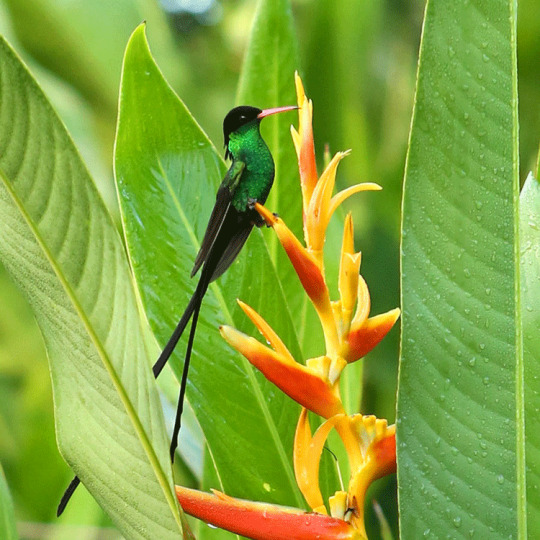
This bird represents the reincarnation of dead souls and it's for being quick, and difficult to kill. AKA the G-d Bird.
The folk song about them inspired me more for them:
“Doctor Bud a cunny bud, hard bud fe dead”. (It is a clever bird which cannot be easily killed).
I also use it for both of the sisters to represent good luck sometimes in unexpected ways. They won't win the lottery overnight but they won't meet others' misfortune.
39. How superstitious your oc? Do they end up following them ‘just in case’? Or are superstitions incredibly important to your oc? What are some that they believe? What about the ones they don’t?
To put it like this, Tina is on the end closer to the "Then how do you explain the dead unicorns?" debate of "There's no such thing as trolls".
She may not be particularly superstitious but Tina has enough Jamaican upbringing (general POC parenting) to not fool around with things she doesn't understand.
Tina will carry a good luck charm maybe but don't expect her to freak out if she doesn't follow a ritual.
40. Are there any habits your oc has picked up from people around them? Do they know where they’re from? Does your oc try to stop themselves from doing it?
Tina picked up her slight nail-biting from her dad and she knows it's from him after Nessa told her as a kid.
She will try to stop herself but bad habits take a while to die when stressed.
3 notes
·
View notes
Video
Red-billed Streamertail (endemic to Jamaica) by Michael W Potter Via Flickr: Red-billed Streamertail is a national symbol of Jamaica, commonly referred to as the “Doctor Bird.” This species of hummingbird is found only on that island in the Caribbean Sea.
#bird#birds#nature#wildlife#birdwatching#Jamaica#Caribbean#Michael W Potter#Luminous Compositions#Red-billed Streamertail#Trochilus polytmus#Trochilidae#Hummingbirds family#National Bird of Jamaica#National Symbol of Jamaica#“Doctor Bird”#iridescence#iridescent#endemic to Jamaica
35 notes
·
View notes
Text

Red-billed Streamertail (Trochilus polytmus), male, family Trochilidae, endemic to Jamaica
photograph by Rafael Rodriguez Mojica
145 notes
·
View notes
Text

[https://www.inaturalist.org/observations/10351622] Red-Billed Streamertail || Trochilus polytmus Observed in Jamaica Least Concern in location of observation
#hummingbird#birds#nature#wildlife#photography#air beast#who cooks for queue? who cooks for queue all?
13 notes
·
View notes
Text
[Prints Now Available]
Zun zun The Taino Hummingbird Man
Illustrator: Angel Ortiz and Sean Behme
We based this piece on an old Taino myth, (here is some Intel on the story but i kept it to the broad stroke) were two star crossed lovers where force apart because of there circumstances. Zun zun's lover was transformed by the Zemi (spirits) into a beautiful flower and hidden away in the forest to save her from her fate. On the next day her lover Zun zun came to whisk her away but was too late and thought she had perished. Another Zemi took pity on him and told him that she was still alive in a new form but did not know her location. So on his request the Zemi proceeded to transform him into a hummingbird so that he can be capable to locate her and reunite with his love.
In our interpretation we decided to give him more of a half human/bird appearance, but to an ordinary human Zun zun is only perceived as a normal hummingbird. We based his look on the Red-billed streamertail, a hummingbird indigenous to Jamaica and also on an old Zemi figure based on a hummingbird. We wanted to show representations to the Tainos of Jamaica, designing him to be more Afro-native. We also wanted to show support and recognition to Afro-indigenous people something there not enough of.
(To add in a bit of info, to the Taino culture hummingbirds are seen as a symbol of masculinity and/or a warrior. But don't quote me on this I'm still learning.)
We Hope you like this piece, we try to be as accurate as possible with the information we have but we don't mind being corrected and informed on new details. Taino myth and legends can be hard to come by and can sometime be mixed with other Pre-Columbian cultures or can be inaccurate and modified by others over time. So basically we're trying our best.
Available At Etsy: https://www.etsy.com/listing/1107073286/zun-zun-the-taino-hummingbird-man
#Taino #Tainoart #Duskwingarts #Arawak #Zunzun #Zun #hummingbird #hummingbirdman #tainomyth #tainolegend #indigenous #indigenousart #art #myth #legend #Jamaica #puertorico #borinquen #zemi #cemi #spirits #Tainoartist #flower #Tribal #Fairy #warrior #Caribbean #AfroTaino #DakaTaino #Afroindigenous


#taino#Tainoart#art#DuskWingArts#arawak#zunzun#zun#hummingbird#hummingbirdman#tainomyth#tainolegend#indigenous#indigenous art#myth#legend#jamaica#puerto rico#borinquen#zemi#cemi#spirits#taino artist#flower#tribal#fairy#warrior#carribean#afrotaino#afro indigenous#daka taino
28 notes
·
View notes